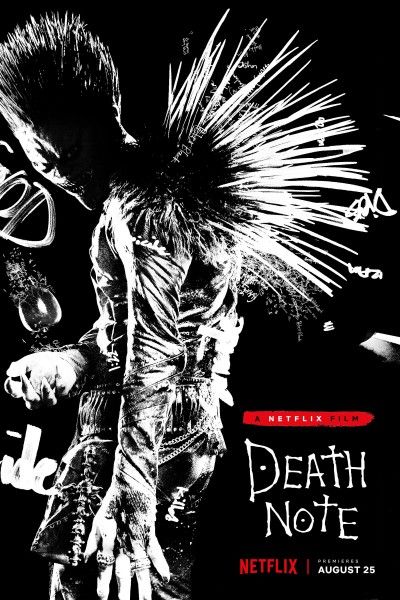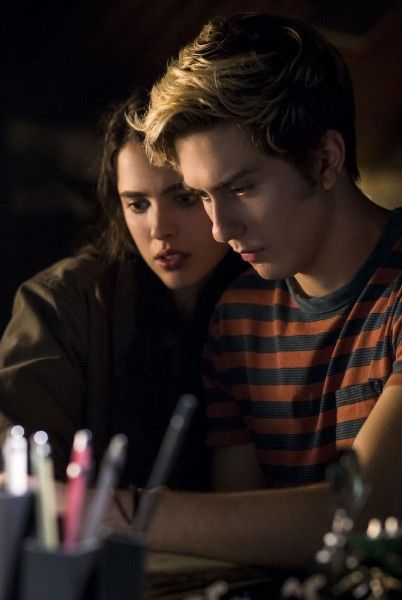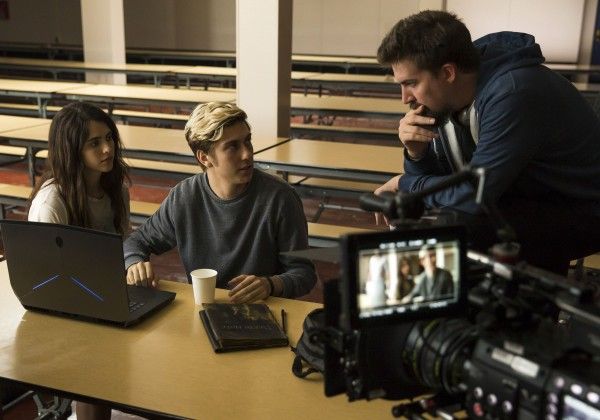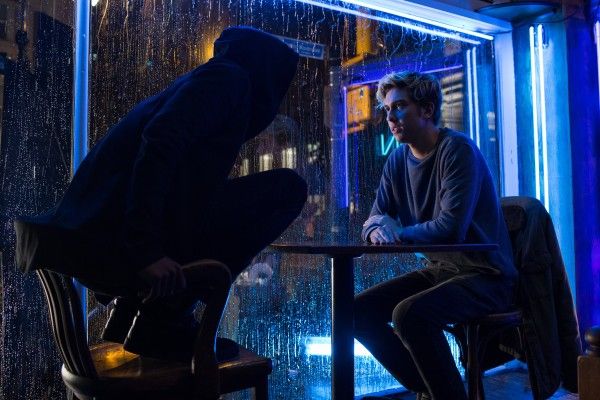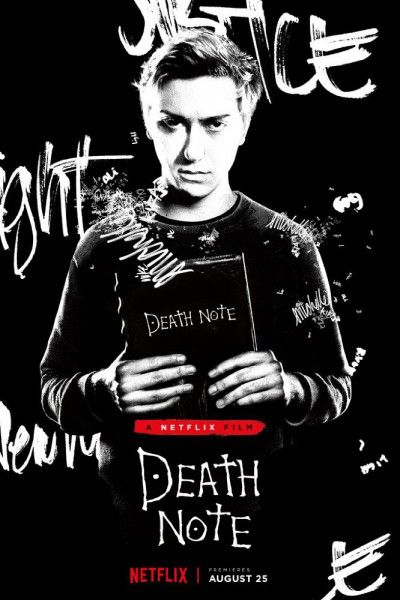From director Adam Wingard and based on the famous Japanese manga written by Tsugumi Ohba and Takeshi Obata, Death Note follows high schooler Light (Nat Wolff), who comes across a supernatural notebook. Upon realizing that it holds a dangerous and scary power that allows its owner to write someone’s name in it while picturing their face, resulting in their death, Light quickly becomes caught up in the godlike ability offered to him by Ryuk (voiced by Willem Dafoe), attracting the attention of his classmate Mia (Margaret Qualley), as well as the mysterious L (Lakeith Stanfield).
During this 1-on-1 phone interview with Collider, actor-turned-producer Masi Oka talked about why he wanted to get involved with the development process for Death Note, working directly with the creators of the original source material so that they were aware of any and all changes, how nervous he was to screen the finished product for them, how his cameo came about, how he feels about the culture changes, seeing this as Light’s origin story, and what he’s most proud of, in regard to what they were able to get accomplished with the film. He also talked about producing a Mega Man movie with directors Henry Joost and Ariel Schulman, currently in the early stages of development, and what’s next for him, as an actor.
Collider: How did you get involved as a producer for Death Note? You’re not known as a producer, so what was it about this project that made you want to see it through the development process?
MASI OKA: I was born in Japan and moved to L.A. when I was six, and I grew up with Japanese culture. I was reading manga, and I read Death Note in real time in Japanese. I’ve actually known this property long before any of the filmmakers. That, I can guarantee. So, I grew up with this and I’m a big fan of this, and I wanted to protect the property. By that, I mean that I wanted to make sure the creators were involved and their voices were heard. I’ve seen many adaptations in the past where the creators weren’t involved. Hollywood generally goes off their own way and pushes them aside. As a fan, I felt the best way to do that was as a producer, so I could be there from ground zero and shepherd the project. That’s why I wanted to get involved in producing, in the first place.
Getting to see the finished product now, what are you most proud of with how it all turned out and what you were able to get accomplished with it?
OKA: We had a great producing staff and great filmmakers, but for me, my mission in this, as a producer, was to make sure that the creators were happy with the film and that their voices were heard. I felt, if the creators were proud and happy with the film, then in turn, the fans would be proud and happy with the film because the creators know the fan base, inside and out. So, my proudest moment was when I had the opportunity to go to Japan and show the creators an early cut of the film in a screening, and they said, “Thank you, this is a great film.” That really brought a tear to my eye. For me, that was my main and most important objective, as a producer on this film.
Were you nervous during that entire screening?
OKA: Yes, of course! Throughout the process, they knew of the creative choices we made. We always consulted them on every script. On the huge creative decisions that needed to be made, I consulted with the creators and said, “What do you guys think? What are your concerns?” There were things that we agreed on, and there were things that Adam wanted a certain way and we accepted that, but they were aware of all of the choices. I knew that they knew what the film content was, but the execution is always different. I was really on pins and needles, hoping that they’d enjoy it. That was probably the longest two hours of my life.
Because you’re a fan of this world, did you insist on a cameo in the film, or did they convince you to do that?
OKA: I didn’t need to be convinced to do it. I wasn’t in Vancouver for the whole shoot, but I happened to be in Vancouver when they were doing the scenes set in Japan. They knew I was going to be there at that time, so they said, “Hey, why don’t you do this?” I’m an actor, as well, so it’s fun to have a small cameo part in this. When Adam asked me to do it, I said, “Of course, I’d love to do it!” I wasn’t forced to do this. Hopefully, all of the movies that Adam produces, from now on, I can have a cameo in and be like Stan Lee. If Adam forces me to be in Kong vs. Godzilla, I’m pretty sure I’ll say yes, as well.
Anytime you take a story out of the culture that it’s rooted in and you change where it’s set, people are going to have an opinion. As someone who is a fan of the original source material, how did you feel about that change? Is the most important thing in all of this the fact that the characters and concepts are still there?
OKA: Yes, definitely! There’s a lot of respect and love that Adam showed for the property and he had a very strong vision, which I think was really important. We’ve already had many live-action adaptations of Death Note in Japan, both in movies and in TV. That set the tone for Adam to try to do something different and creative. There were definitely some character changes and some story changes, but the core of it was definitely a Death Note film. As a fan, it’s a little bit different, but Adam is such a great filmmaker that you trust in knowing what he can do with the material and the visual of it. He brought an intelligence and a respect to it. I think there was a mutual respect, in terms of that. I think there were concerns, but I was never worried, at all.
This is a movie that is fun to watch and it has a lot of insane death scenes, but it also has a lot to say about society. What do you hope people take from this story?
OKA: This is about the youth and empowering the youth. It’s about trying to get people to think about how the youth aren’t powerless. If you have the opportunity to make a change in the world, what would you do with it? Of course, everybody has a different approach to it. Even people that are evil believe what they’re doing is good. I don’t agree with those people, but it’s about understanding that there are those kinds of points of view. With every action, there’s a great consequence to it. It’s about making people feel that they’re not powerless, and it also makes you wonder what you’d do with the power to change the world.
This story doesn’t have a sense of finality to it, at the end. There are still unanswered questions. Would you like to revisit this story and see where else this could go?
OKA: Absolutely! Just like the morality isn’t black and white, our story doesn’t have a black and white ending. There are still stories to tell. We’ve always imagined this as an origin story for Light. At the end of the film, the character is an emotional place where Light begins in the manga. Now, he’s accepted himself as an anti-hero. That’s where the second round of Light vs. L happens. Hopefully, we’ll have the opportunity and the privilege to make a sequel, provided that the fans and Netflix respond.
If you were just a fan of the original source material, watching this movie, what do you think you would most respond to?
OKA: First of all, Ryuk being so cool. In the old live-action stuff, he was all CG, so it’s nice to see Willem Dafoe bring that to life. And I think I would definitely respond to the chess match between Light and L. There are definitely some scenes that are, frame by frame, straight out of the manga series. And they kept the apple. At the same time, I would respond to the fact that this is a really great adaptation. I’ve seen many that didn’t work as well. Knowing that they were setting this in a different culture, I was expecting something different from the get-go. And not only did I think it was a terrific adaptation, but it was a great film, on its own.
Are you still working on producing a Mega Man movie?
OKA: We’ve just started the Mega Man movie. The writer/directors are working on a script right now, and we’re just in the beginning development stages of that.
What are you most excited about with that, and are there challenges specific to producing a story that’s based on a best-selling video game vs. a hugely popular manga?
OKA: With manga, there’s a lot of character development and it’s a serialized story. With a video game, it’s about game mechanics. The story might be a little bit lighter. There are definitely challenges with that, but I’m excited because our directors are big fans of the game. With anything animated, a game property, or anything IP, you want to make sure the filmmakers are huge fans because they’ll show a respect for the property and understand, at the core, what makes that property great. I don’t know where it’s going to go yet, but I am excited about Henry Joost and Ariel Schulman. They’re great filmmakers and they’re really big fans of Mega Man.
Are you hoping for a cameo in that, as well?
OKA: Yeah, I’d love a cameo! I’ll probably have some sort of cameo and most likely I’ll die in it.
What’s next for you, as an actor?
OKA: Right now, I’m shooting a couple of episodes of Mozart in the Jungle, which is an Amazon series. And then, they’re releasing a movie I did with Jason Statham, called Meg, in 2018. There are a couple of other things in the works, both in front of the camera and behind the camera, that haven’t been announced yet, but hopefully will be soon.
How was the experience of making Meg?
OKA: Fantastic! I was there for the first two weeks of shooting and it was great. The crew was super fresh and excited to be there. It was fun and we got to do a lot of takes. It was pretty cool! I’d never been to New Zealand. It was my first time in New Zealand, and it was a beautiful country. It was a very happy experience. The movie looks great, too. I’ve seen some cuts of it.
Death Note is available to stream at Netflix.


